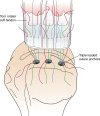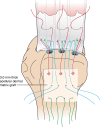Patch Augmentation in Rotator Cuff Repair
- PMID: 32720101
- PMCID: PMC7474721
- DOI: 10.1007/s12178-020-09658-4
Patch Augmentation in Rotator Cuff Repair
Abstract
Purpose of the review: Rotator cuff repair has excellent outcomes for many patients but continues to be suboptimal for large, retracted tears, and revision procedures. In these situations, patch augmentation may be considered in order to improve healing. The purpose of this article is to review the history, graft options, indications, surgical technique, outcomes, and complications associated with arthroscopic patch augmentation for rotator cuff repair.
Recent findings: Patch augmentation has been shown in several studies to improve healing rates. After multiple investigations into different materials available for patch augmentation, acellular dermal allograft seems to be the graft with the best scientific support. While multiple techniques have been presented, few studies have compared their performance. While the arthroscopic technique for patch augmentation can be challenging, we present a systematic approach to this procedure with the potential to reliably and predictably perform patch augmentation. This technique is a valuable tool for surgeons that treat rotator cuff pathology.
Keywords: Biologic augmentation; Dermal allograft; Patch augmentation; Rotator cuff repair; Surgical technique.
Conflict of interest statement
Peter Chalmers is a paid consultant for Depuy-Mitek and Arthrex. Robert Tashjian is a paid consultant for Zimmer Biomet, Wright Medical and Depuy-Mitek; has stock in Conextions, INTRAFUSE, Genesis and KATOR; receives intellectual property royalties from Wright Medical, Shoulder Innovations, and Zimmer Biomet; receives publishing royalties from Springer, the Journal of Bone and Joint Surgery and the Journal of the American Association of Orthopaedic Surgeons, and serves on the editorial board for the Journal of the American Association of Orthopaedic Surgeons.
Figures








References
-
- Cai Y-Z, Zhang C, Jin R-L, Shen T, Gu P-C, Lin X-J, et al. Arthroscopic rotator cuff repair with graft augmentation of 3-dimensional biological collagen for moderate to large tears: a randomized controlled study. Am J Sports Medicine. 2018;46(6):1424–1431. doi: 10.1177/0363546518756978. - DOI - PubMed
Publication types
LinkOut - more resources
Full Text Sources
Research Materials

